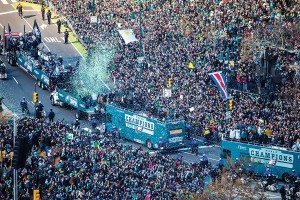20 Ways to Make Philadelphia the Best Damn City in America
11. SELL THE PECO BUILDING TO DREXEL.
We love to talk about how Penn and Drexel transformed West Philly, so why don’t we invite them to move east of the Schuylkill and rejuvenate wasteland-ish West Market? Start by orchestrating PECO’s sale of its headquarters to Drexel, and feel the youthful university vibe spread (hopefully cleansing the bad mojo from all those who’ve waited in line to deal with the utility). The timing couldn’t be better: CHOP’s purchased east-side real estate, and John Fry has started his tenure at Drexel. Fry was by Judy Rodin’s side when she was beautifying Penn’s environs, and while we’re all in favor of his recently announced, but not totally earth-shaking, plans for improving Drexel’s immediate neighborhood, he must be feeling Constantine Papadakis’s legacy breathing down his neck. By going east, Fry makes a huge splash, and Center City dwellers start to feel more connected to the left bank. Bonus: Drexel can lease the Murano condo building for VIP student housing. We hear there are rooms available.
12. TURN THE NAVY YARD INTO THE GREEN YARD.
By Natalia Olson Urtecho, president and CEO, Ecolibrium Group
Fossil fuel depletion, rapid urbanization, growing population, climate change, and exhaustion of natural resources are all driving up demand for cleaner, more efficient and more sustainable energy solutions, and the Philadelphia region is poised to be at the forefront of America’s clean energy economy, with the Navy Yard at the epicenter. The seed money is already coming in: There’s the recently won $129 million research grant for a Penn State/Navy Yard collaboration on energy-efficient buildings. “Cleantech” research at local universities is well established; Drexel alone received two major federal grants for it this year. We even have the Greater Philadelphia Innovation Cluster, a consortium of businesses, universities and nonprofits that have come together to work on this issue.
Of course, the tough part will be implementing regional policies that support the work; providing incentives for collaboration among university researchers and established businesses; and getting the public to back these efforts. Already, hubs of cleantech entrepreneurship are forming to capitalize on that trend. China continues to advance, and is creating clean-energy jobs much more successfully than the United States. For Philadelphia to lead, we’ll require major transformations in the way we think about innovation, and in how we produce, transmit and consume energy. It will also require a change in the way we think about Philadelphia.
In 1876, visitors came here from all over the country — and the world — when Philadelphia hosted the World’s Fair, which celebrated an era of innovation and entrepreneurship. They were introduced to everything from the first typewriter and telephone to the new steam engine and Heinz ketchup. The city is again on the verge of being the country’s leader, ushering in an era of innovation. What’s cleantech research bringing the world? Everything from eco-friendly cement to algae-generated oil to window shutters that collect solar energy. What’s in it for us? Analysts predict a cleantech boom that will see the alternative-energy industry’s revenues quadruple to $226 billion by 2017. This means new industries and new jobs, at a time when we desperately need them.


